Ordnance QF 17-pounder

Ordnance QF 17-pounder

| Ordnance QF 17-pounder | |
|---|---|
| Type |
|
| Place of origin | United Kingdom |
| Service history | |
| In service | 1943– |
| Used by | British Commonwealth |
| Wars |
|
| Production history | |
| Designed | 1941–42 |
| Produced | 1942- |
| Specifications | |
| Mass | 3 long tons (3.05 t) |
| Barrel length |
|
| Width | 2.2 m (7 ft 3 in) |
| Height | 1.6 m (5 ft 3 in) |
| Crew | 5-6 |
| Shell | Fixed QF 76.2×583mmR |
| Calibre | 3 inches (76.2 mm) |
| Breech | Vertical sliding breech |
| Recoil | Hydro-pneumatic |
| Carriage | Split trail carriage, with gun shield. |
| Elevation | -6° to +16.5° |
| Traverse | 60° |
| Rate of fire |
|
| Muzzle velocity |
|
| Effective firing range | 1.5 km (0.93 mi) |
| Maximum firing range | 10.5 km (6.5 mi)[5] |
| 77 mm HV | |
 77 mm HV Mk2 on a Saracen prototype armoured car | |
| Type | Tank gun |
| Place of origin | United Kingdom |
| Production history | |
| Designer | Vickers |
| Manufacturer | Vickers |
| Specifications | |
| Mass | 1,502 pounds (681 kg) |
| Length | 13.8 feet (4.2 m) |
| Calibre | 76.2 millimetres (3.00 in) |
| Elevation | +20/-14 on Comet |
| Effective firing range | 2,000 yards (1,800 m) |
The Ordnance Quick-Firing 17-pounder (or just 17-pdr)[1] was a 76.2 mm (3 inch) gun developed by the United Kingdom during World War II. It was used as an anti-tank gun on its own carriage, as well as equipping a number of British tanks. Used with the APDS shot, it was capable of defeating all but the thickest armour on German tanks. It was used to 'up-gun' some foreign-built vehicles in British service, notably to produce the Sherman Firefly variant of the US M4 Sherman tank, giving British tank units the ability to hold their own against their German counterparts. In the anti-tank role, it was replaced after the war by the 120 mm BAT recoilless rifle. As a tank gun, it was succeeded by the 84 mm 20 pounder.
| Ordnance QF 17-pounder | |
|---|---|
| Type |
|
| Place of origin | United Kingdom |
| Service history | |
| In service | 1943– |
| Used by | British Commonwealth |
| Wars |
|
| Production history | |
| Designed | 1941–42 |
| Produced | 1942- |
| Specifications | |
| Mass | 3 long tons (3.05 t) |
| Barrel length |
|
| Width | 2.2 m (7 ft 3 in) |
| Height | 1.6 m (5 ft 3 in) |
| Crew | 5-6 |
| Shell | Fixed QF 76.2×583mmR |
| Calibre | 3 inches (76.2 mm) |
| Breech | Vertical sliding breech |
| Recoil | Hydro-pneumatic |
| Carriage | Split trail carriage, with gun shield. |
| Elevation | -6° to +16.5° |
| Traverse | 60° |
| Rate of fire |
|
| Muzzle velocity |
|
| Effective firing range | 1.5 km (0.93 mi) |
| Maximum firing range | 10.5 km (6.5 mi)[5] |
| 77 mm HV | |
 77 mm HV Mk2 on a Saracen prototype armoured car | |
| Type | Tank gun |
| Place of origin | United Kingdom |
| Production history | |
| Designer | Vickers |
| Manufacturer | Vickers |
| Specifications | |
| Mass | 1,502 pounds (681 kg) |
| Length | 13.8 feet (4.2 m) |
| Calibre | 76.2 millimetres (3.00 in) |
| Elevation | +20/-14 on Comet |
| Effective firing range | 2,000 yards (1,800 m) |
Development history
Gun development
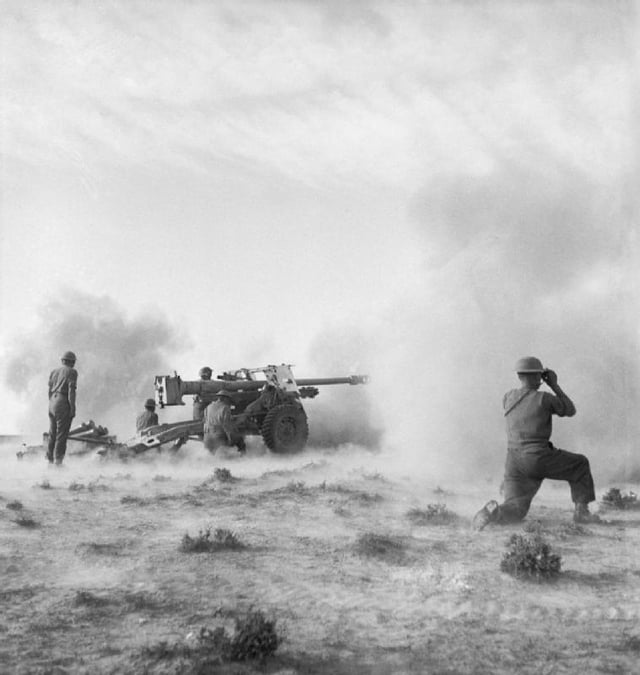
'Pheasant' 17-pdr anti-tank gun in action at the Battle of Medenine, Tunisia, 11 March 1943
Before the QF 6-pounder had entered service, the British predicted that it would soon be inadequate given the increasing armour of German tanks. In late 1940, the design of a replacement began, and was largely completed by the end of 1941. A prototype production line was set up in spring 1942, and with the appearance of Tiger I tanks in early 1943 in the North African Campaign, the first 100 prototype 17-pounder anti-tank guns were quickly sent to help counter this new threat. So great was the rush that they were sent before proper carriages had been developed, and the guns had to be mounted in the carriages of 25-pounder gun-howitzers. These early weapons were known as 17/25-pounders and given the codename Pheasant. They first saw action in February 1943.
Fully developed 17-pounders started production in 1943 and were first used during the Italian Campaign. They became one of the most effective weapons on the battlefield, on both carriages and tanks.
The 17-pounder anti-tank guns also saw action in Korea against tanks and in general support use against bunker positions. After Korea, the gun was largely replaced in the tank role by the Ordnance QF 20 pounder, and in the anti-tank role by the BAT, MOBAT and 120 mm L6 WOMBAT series of recoilless rifles.
Adaptation into tanks and AFVs
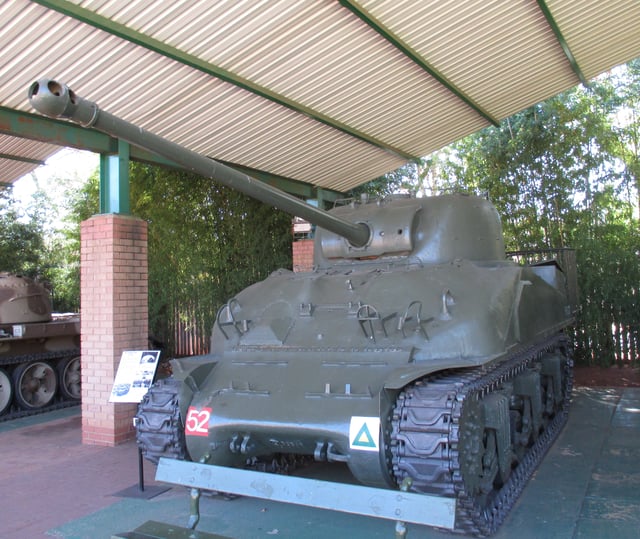
A Sherman Firefly with the 17-pounder
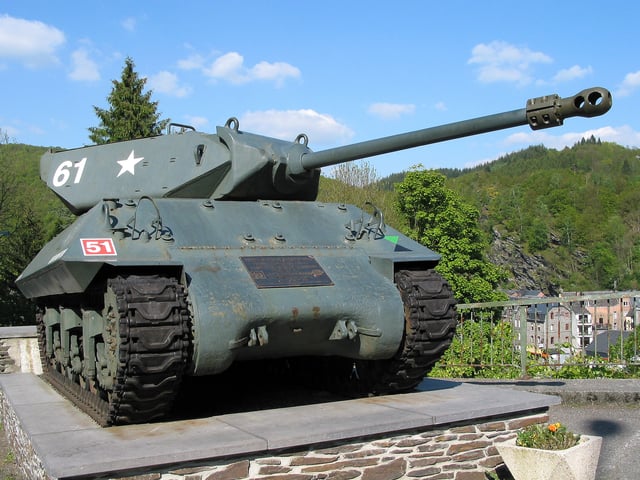
17-pounder SP Achilles of the Battle of the Bulge in La Roche-en-Ardenne.
The 17-pounder outperformed all other Allied armour-piercing guns, and was quickly adapted for use on various tank chassis. However, few tanks were capable of carrying such a large gun due to the size limitations of their turret rings. A new British tank specification, A29, was produced to meet the need for a 17-pounder armed cruiser tank. While the A29 was eventually cancelled without a successful design being produced, an amended specification, A30, reached production in 1943. The A30 specification reduced weight and enabled the use of Cromwell tank components as a design expedient. The resulting Cruiser Mark VIII Challenger had a longer hull and provided a larger turret, allowing the 17-pounder to be mounted along with space for a second loader, thought to be required for the gun's larger ammunition. However, production of the tank took time and few could be completed before the allied invasion of Normandy.
While developing the Challenger tank, the British devised a conversion for their US-supplied M4 Sherman tanks to mount the 17-pounder. This was applied in sufficient numbers to put them into service in time for D-Day as the Sherman Firefly. The gun, a modified design that was produced specifically for the Firefly, was rotated through 90 degrees to mount into the turret of the Sherman, i.e. it lay on its side. An additional box was welded to the back of the turret to take the radio, which was moved to allow for the breech and its recoil.[2] Additionally, a new recoil mechanism, based on that of the 6-pounder was developed to further shorten the recoil, while also shortening the gun cradle[6]. Production of the Challenger was cancelled, and more Shermans were converted until about 50% of Shermans in British service were Fireflies.
The British also converted some of their US-produced M10 tank destroyers, replacing the 3-inch (76 mm) gun with the 17-pounder; the resulting vehicles were called 17pdr SP Achilles or just 17-pdr M10. These served with Royal Artillery as self-propelled guns.
The 17-pounder was also successfully trialled on the Australian-designed Sentinel tank, though no Sentinels equipped with this gun entered service with the Australian Army.
A variant of the 17-pounder, the 77mm HV, was used on the Comet tank. A separate weapon, this fired 17-pounder projectiles in a more tank-compatible form, and ultimately replaced the need for 17-pounder tanks late in the war.
As the war came to a close, the 17-pounder was also deployed on the Centurion tank, until ultimately being replaced by the 20-pounder.
The United States Army did not use the 17-pounder, though the gun was offered to US forces with a number of Sherman tanks modified for testing.[7] US tanks began to use the 76 mm gun M1 instead.
Variants
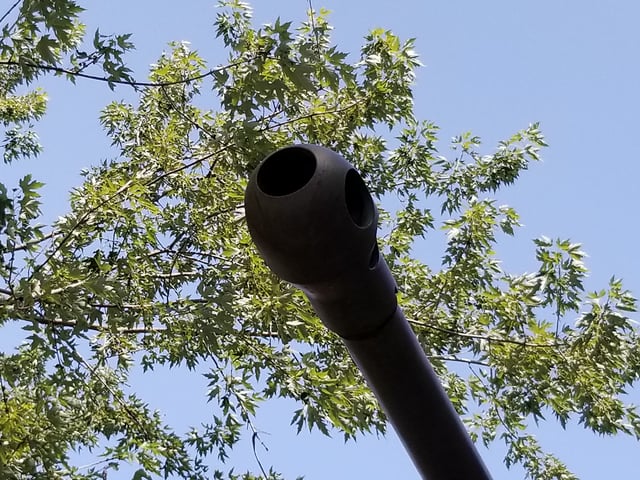
Muzzle brake Ordnance QF 17 pounder
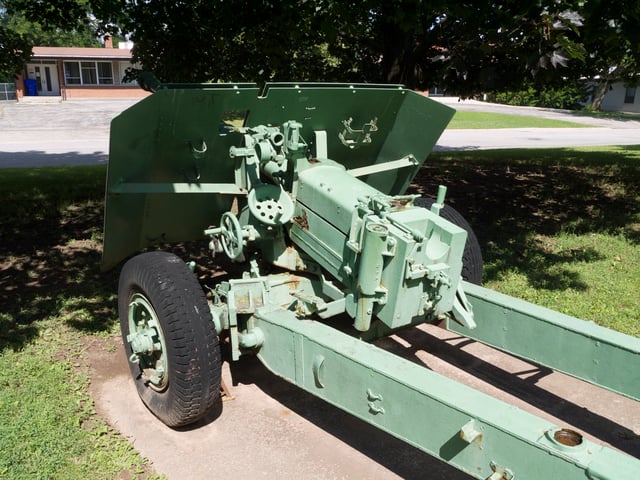
Rear view of QF 17-pounder displayed in Burlington, Ontario
- Mark Ifirst production versions.Mark IIintended for tank use. Removed the carrier mountings and replaced themuzzle brakewith a counterweight. The brake was added back on in March 1944 with the introduction of the APDS shot. The Mk. II was used on theArcherself-propelled anti-tank gun andCruiser Mark VIII Challengertank.Mark IIIRoyal Navyadaptation for use onlanding craft, generally similar to the Mk. I, but included an automatic loading system. Unused.Mark IVAnother tank adaptation, this time with a different breech where the block slid to the side instead of down to take up less room. Used onSherman Firefly.Mark VA version of the Mk IV with different mounts to allow it to replace the US3 in (76.2 mm) Gun M7on the3 in SP, Wolverines, creating the17pdr SP Achilles.Mark VIAnother Mk. IV adaptation with a shortened breech.Mark VIISimilar to the Mk. VI, yet another change to the breech.Straussler ConversionThis was an experimental gun, designed byNicholas Strausslerthat was fitted with a motorized gun-carriage. A modifiedammunition limberwould be attached to the gun's trails, making a four-wheeled, self-propelled vehicle and removing the need for a truck to tow the gun.[8]
77 mm HV
The British started work on developing a gun that was small enough to fit on their tank designs—particularly the Cromwell cruiser tank then at the design stage. It was intended to fire the US 75 mm projectiles (AP shot and HE) at a higher velocity, avoiding a downgrade in armour penetration versus the 6-pounder, which the dual purpose 75mm was replacing.
The new 50-calibre long gun, known as the Vickers HV 75 mm, fired a 75mm projectile attached to a necked down 3-inch (76.2 mm) 20 cwt AA gun cartridge through a modified breech. The larger 3" cartridge provided a greater propellant charge compared with normal 75mm shells. Although the 75 mm HV was a promising weapon, it proved to be too big for the Cromwell tank, which was ultimately fitted with the normal QF 75 mm gun in use on other British tanks. To account for this difference, tank squadrons were teamed with Challenger and Sherman Firefly tanks armed with the 17-pounder.
When the Cromwell's replacement, the Comet, was at the design stage, the 75 mm HV concept was reworked to fire the same projectiles as the 17-pounder through a shortened 17-pounder barrel, but retaining the 3-inch cartridge case firing from a standard 3-inch breech.[9]
This has the benefit of greater ease of use on tanks, many of which would not have sufficient turret space to accommodate the breech length and recoil distance of the 17-pounder. Similarly, the smaller 3" based ammunition was easier to store and handle in the tank's cramped interior.
This new gun's ammunition was not interchangeable with the 17-pounder, however, and to prevent confusion over ammunition supplies, it was renamed the 77 mm HV—the 'HV' standing for High Velocity—although it was the same 76.2 mm calibre as the 17-pounder.
Ammunition
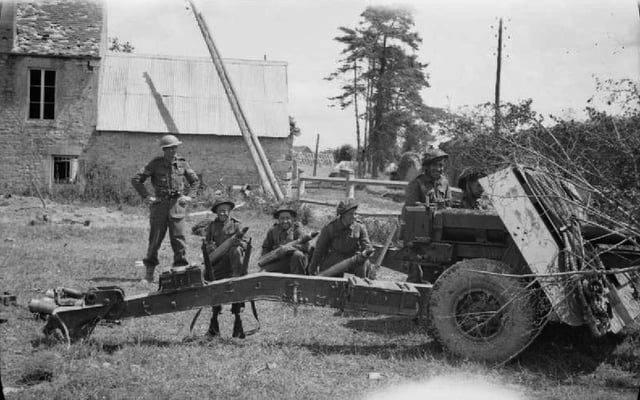
17-pounder gun, three loaders standing by with AP ammunition during Operation Epsom, 27 June 1944.
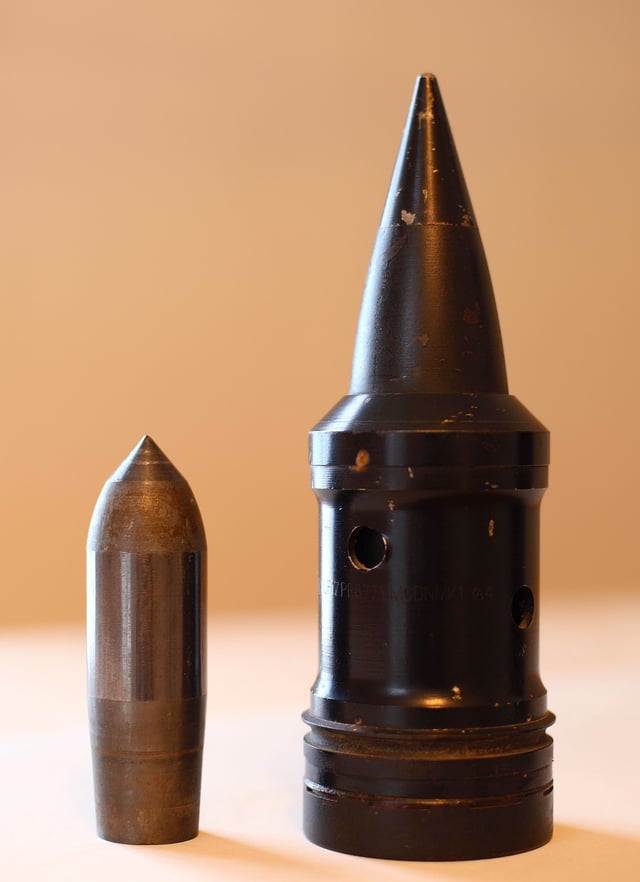
complete 17pdr Armour-Piercing Discarding-Sabot (APDS) shot and tungsten carbide core side by side
The 17-pounder used three types of anti-tank ammunition along with a high explosive shell:
- Armour Piercing Capped (APC)Armour Piercing Cappedwas a basic AP shell used with field guns, but was not used when the 17pdr was mounted in the Sherman Firefly tank.[10]Armour Piercing, Capped, Ballistic Capped (APCBC)Armour Piercing, Capped, Ballistic Cappedammunition could penetrate 163 mm of armour at 500 metres and 150 mm at 1000 m.Armour-piercing discarding sabot (APDS)Armour-piercing discarding sabotcould penetrate 256 mm of armour at 500 m and 233 mm at 1000 m,[11][3] and allowing it in theory to penetrate the armour of even the GermanTiger IIheavy tank. Most sources are in agreement that APDS was not available on D-Day itself, but reached Normandy in increasing amounts by the end of June or early July 1944. It was available for the breakout battle from Normandy and the advance to the Netherlands and Germany. The weight of the enclosed shot, excluding the enclosing sabot, was 7.7 lb (3.5 kg).High Explosive (HE)The HE shell initially developed for the 17-pounder lacked power. Due to the high-powered cartridge, the shell walls had to be thicker to stand the stresses of firing, leaving less room for explosive. Reducing the size of the propelling charge for the HE shell allowed the use of a thinner-walled and more powerful shell. Two HE shells were developed, one with 1.08 lb (0.490 kg) of explosive, producing 2050 Kilojoules, and one with 1.28 lb (0.580 kg) of explosive, producing 2400 Kilojoules.
APCBC ammunition was the standard ammunition for the gun, while APDS shot was used for about 6% of the average load of a 17-pounder-equipped British tank.
While offering greater penetration, the smaller (sub-calibre) tungsten core of APDS was considered to provide less accurate fire than APCBC ammunition at ranges beyond 500 yards.[12] This was due to the much lesser visible impact of rounds that fell short, making it hard to spot the fall of shot and correct aim. The APDS was also considered to cause less damage to an enemy tank if it did penetrate the armour, but the sub-calibre tungsten steel core tended to destabilise after penetrating armour and ricochet around inside the target, causing crew casualties.
The 17-pounder produced a very large muzzle flash due to the large amount of propellant in its cartridges. Muzzle blast was also significant, described by crews of the anti-tank gun variant as resembling a hard slap on the chest.
Performance
| Gun type | Ammunition type | Muzzle velocity (m/s) | Penetration (mm) | ||||||||||
|---|---|---|---|---|---|---|---|---|---|---|---|---|---|
| 100 m | 250 m | 500 m | 750 m | 1000 m | 1250 m | 1500 m | 1750 m | 2000 m | 2500 m | 3000 m | |||
| QF 77 mm | APCBC | 785 m/s (2,580 ft/s) | 147 | 143 | 137 | 131 | 126 | 121 | 116 | 111 | 106 | 98 | 90 |
| QF 77 mm | APCBC FH | 785 m/s (2,580 ft/s) | 157 | 153 | 147 | 141 | 135 | 130 | 124 | 119 | 114 | 105 | 96 |
| QF 17 pdr | AP | 884 m/s (2,900 ft/s) | 200 | 190 | 175 | 160 | 147 | 135 | 124 | 114 | 105 | 88 | 74 |
| QF 17 pdr | AP FH | 884 m/s (2,900 ft/s) | 164 | 156 | 144 | 132 | 121 | 112 | 103 | 94 | 87 | 73 | 62 |
| QF 17 pdr | APCBC | 884 m/s (2,900 ft/s) | 174 | 170 | 163 | 156 | 150 | 143 | 137 | 132 | 126 | 116 | 107 |
| QF 17 pdr | APCBC FH | 884 m/s (2,900 ft/s) | 187 | 182 | 175 | 167 | 161 | 154 | 148 | 141 | 136 | 125 | 115 |
| QF 17 pdr | APDS | 1,204 m/s (3,950 ft/s) | 275 | 268 | 256 | 244 | 233 | 223 | 213 | 204 | 194 | 178 | 162 |
FH marks the performance against face hardened armour (FHA), as opposed to rolled homogeneous armour (RHA).
Use
Anti-tank gun

The complete AP round of a 17-pounder
The 17-pounder was a much bulkier and heavier weapon than its predecessor. As a result, it had to be towed by a gun tractor, such as the Morris Quad, M3 Half-track or the Crusader, as it could not effectively be moved by its gun crew alone, especially on poor ground. After firing on soft ground, the 17-pounder frequently had to be pulled out of the ground due to the gun recoil burying the trail spades. After the Second World War, it was issued to anti-tank units of the Royal Artillery in the British Army of the Rhine (BAOR) towed by the M3 Half Track. When the Royal Artillery anti-tank units were disbanded in 1951, it was transferred to Infantry battalions in the BAOR (six per battalion), towed by the Oxford Tracked Carrier. It was later replaced by the 120 mm BAT recoilless rifle anti-tank weapon.
Pheasant carriage
Also known by the 17/25 pounder designation, a stop-gap measure named Pheasant mated the 17 pounder gun with a modified 25 pounder carriage. This enabled the gun to be pressed into service before its own carriage design was ready.
Split trail carriage
A custom designed carriage for the 17 pounder comprising:
Split trail carriage, with gunshield.
Weight: 3 t.
Elevation: −6° to +16.5°
Traverse: 60°
Middle East
In the immediate post-war era in the Middle East, Arab national armies - Transjordan, Egypt, Syria and Iraq - mainly used British manufactured artillery, including the towed 17-pounder. The Israelis used a number of 17 pounders that they captured from the Arabs in the war of independence[13]
Vehicle mount
World War II
Tank, Cruiser, Challenger (A30) - 200 built
Tank, Cruiser, Comet I (A34) (77 mm OQF HV) - 1,200 by end of war.
SP 17-pounder, Valentine, Mk I, Archer self-propelled anti-tank gun/tank destroyer built on Valentine tank hull, 655 built
Sherman Firefly - Modified Sherman tank (Medium Tank M4), about 2,000
17pdr SP Achilles - Modified 3-inch Gun Motor Carriage M10, about 1,100 by end of war
Tank, Infantry, Black Prince (A43) (experimental development of Churchill tank, never fielded)
TOG2 (prototype tank, never fielded)
Australian Cruiser tank Mk IV (prototype turret only, never fielded)
Post-war
Ratel IFV Concept 1 - a heavily modified South African test-bed chassis.
Eland Mk7 Concept 2 - a heavily modified South African test-bed chassis.
Alvis Saracen Concept 3 - a heavily modified South African test-bed chassis.[14]
Centurion - on A41 prototype and on production Centurion Mk 1 and Mk 2.
SP 17-pounder, A30 (Avenger) - variant of Challenger, not available in time for war, 250 built
See also
Weapons of comparable role, performance and era
7.5 cm KwK 42 German tank gun
76 mm gun M1 US tank gun
D-5T Soviet tank gun
Other weapons in series
Ordnance QF 6-pounder
Ordnance QF 20-pounder
